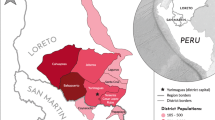Abstract
This study examined the use of traditional and Western health services by Chinese immigrants, as well as the cultural and socioeconomic factors affecting health-seeking behaviors and health service utilization patterns among the study population from the perspectives of consumers and Chinese health care providers. Two instruments were used for data collection. The first, a consumer instrument, was designed for interviews of service recipients; the second, a health provider instrument, was designed to elicit information from traditional and Western providers. A few topics in the former instrument were cross-examined from the perspectives of health care providers. The investigation employed a combination of qualitative and quantitative research methods for data collection. Qualitative ethnographic methods used included: (1) participant-observation, (2) face-to-face interview, and (3) case study. To complement the qualitative data, structured quantitative survey were conducted with all selected informants. A total of 105 informants participated in the study: 75 Chinese consumers and 30 Chinese health professionals. The latter group was composed of Western physicians and traditional practitioners. Results revealed several patterns of health-seeking and service utilization behaviors among the Chinese of Houston and Los Angeles. These included high rates of self-treatment and home remedies (balanced diets and other alternative medicines); medium rates of utilization of integrated Western and traditional health services, including travel to country of origin for care; and low rates of exclusive utilization of Western or traditional Chinese treatments.
Similar content being viewed by others
REFERENCES
U.S. Bureau of the Census. 1990 Census of Population and Housing. Washington D.C.: U.S. Bureau of the Census, 1990.
Wong B. Economic survival: The case of Asian-American elderly. Sociological Perspectives 1987; 27: 197–217.
Association of Asian Pacific Community Health Organizations. Taking action: Improving access to health care for Asians and Pacific Islanders. Oakland: American of Asian Pacific Community Health Organizations, 1995.
Ullman D. The mainstreaming of alternative medicine. Healthcare Forum J 1993; 12:24–30.
Spradley JP. Participant observation. New York: Holt, Rinehart and Winton, 1980.
Schatzman L, Strauss A. Field research: Strategies for natural sociology. New Jersey: Prentice-Hall, Inc., 1973.
Glaser BG, Strauss AL. The discovery of grounded theory. Chicago: Aldine, 1967.
Strauss A, Corbin J. Grounded theory in practice. London: Sage Publications, 1997.
Imperato PJ. Western and traditional medicine in Africa: A century of encounter. Pharos 1995; 58:43.
Walker PF. Health care for new Americans: Blending traditional and Western medicine. Minnesota Med 1992; 75:9–12.
Zhang X. Traditional medicine and WHO. World Health 1996; 2:4–5.
Hoff W. Traditional healers and community health. World Health Forum 1992; 13:182–187.
Freeman M, Motsei M. Planning health care in South Africa: Is there a role for traditional healers? Soc Sci and Med 1992; 34:1183–1190.
Rights and permissions
About this article
Cite this article
Ma, G.X. Between Two Worlds: The Use of Traditional and Western Health Services by Chinese Immigrants. Journal of Community Health 24, 421–437 (1999). https://doi.org/10.1023/A:1018742505785
Issue Date:
DOI: https://doi.org/10.1023/A:1018742505785




